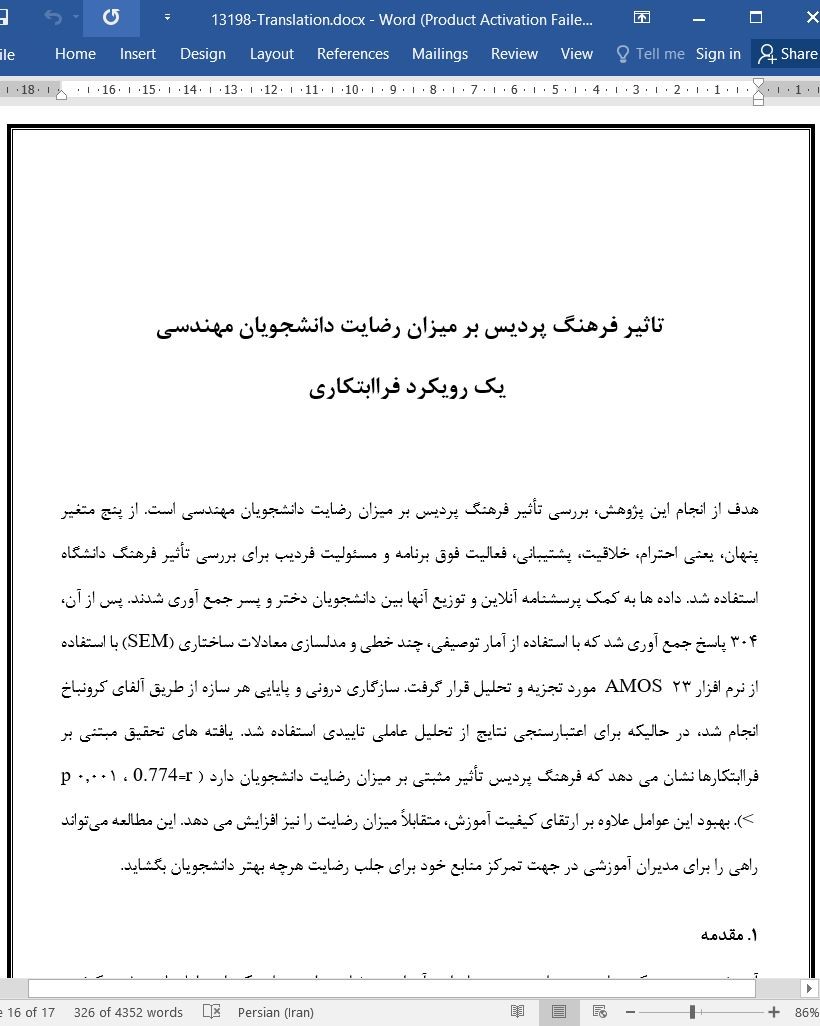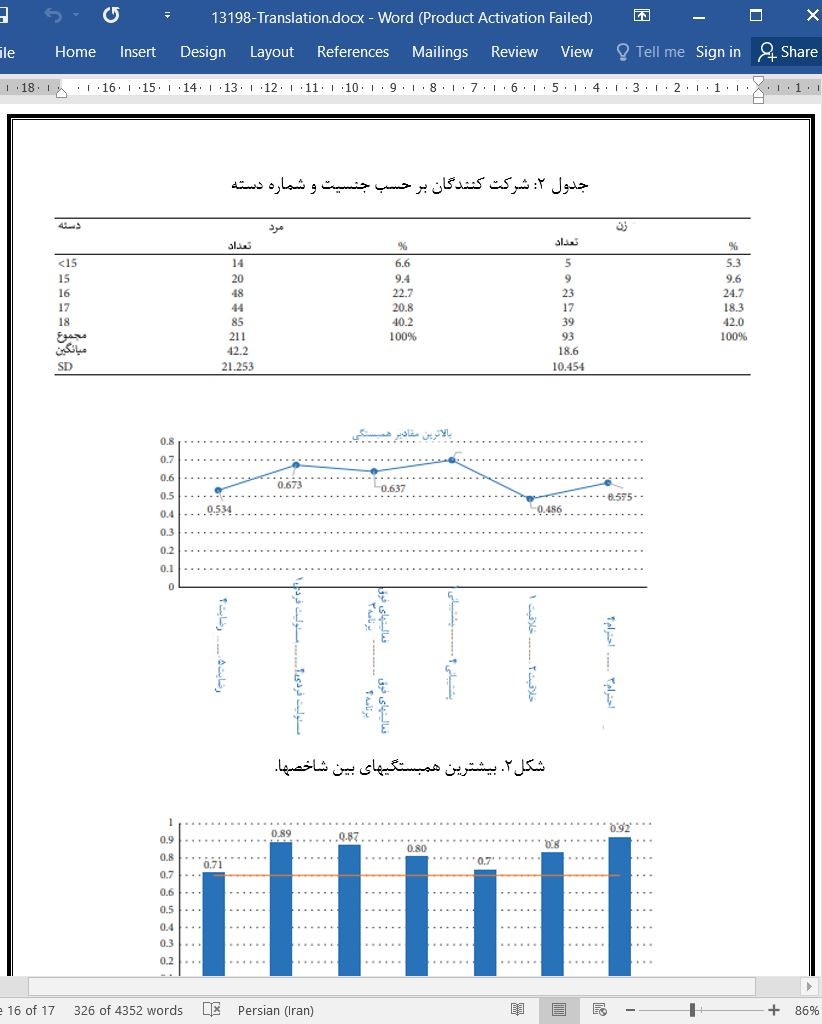
دانلود مقاله تاثیر فرهنگ پردیس بر میزان رضایت دانشجویان مهندسی: یک رویکرد فراابتکاری
هدف از انجام این پژوهش، بررسی تأثیر فرهنگ پردیس بر میزان رضایت دانشجویان مهندسی است. از پنج متغیر پنهان، یعنی احترام، خلاقیت، پشتیبانی، فعالیت فوق برنامه و مسئولیت فردیب برای بررسی تأثیر فرهنگ دانشگاه استفاده شد. داده ها به کمک پرسشنامه آنلاین و توزیع آنها بین دانشجویان دختر و پسر جمع آوری شدند. پس از آن، 304 پاسخ جمع آوری شد که با استفاده از آمار توصیفی، چند خطی و مدلسازی معادلات ساختاری (SEM) با استفاده از نرم افزار 23 AMOS مورد تجزیه و تحلیل قرار گرفت. سازگاری درونی و پایایی هر سازه از طریق آلفای کرونباخ انجام شد، در حالیکه برای اعتبارسنجی نتایج از تحلیل عاملی تاییدی استفاده شد. یافته های تحقیق مبتنی بر فراابتکارها نشان می دهد که فرهنگ پردیس تأثیر مثبتی بر میزان رضایت دانشجویان دارد (r = 0.774، 0.001p < ). بهبود این عوامل علاوه بر ارتقای کیفیت آموزش، متقابلاً میزان رضایت را نیز افزایش می دهد. این مطالعه میتواند راهی را برای مدیران آموزشی در جهت تمرکز منابع خود برای جلب رضایت هرچه بهتر دانشجویان بگشاید.
1. مقدمه
آموزش مهمترین رکن جامعه و مبنای توسعه و پایداری آن است. رضایت دانشجویان یکی از عوامل بارز موثر بر کیفیت آموزش محسوب می شود. رضایت دانشجویان، منجر به نتایج بهتری در یادگیری می شود و آنها را پس از فارغ التحصیلی در رشته تحصیلی خود آماده تر می کند (1). کیفیت خوب آموزش، فرصت های شکوفایی بهتری را فراهم می کند، و میزان رضایت یا عدم رضایت تاثیر زیادی بر موفقیت یا شکست دانشجویان در یادگیری می گذارد. محیط پردیس (درون دانشگاه) مهمترین تأثیر و مشوق برای ارتقای سطح رضایت دانشجویان محسوب می شود و این هدفی است که همه مؤسسات آموزشی طراز اول به دنبال آن هستند. حمایت از دانشجویان از طریق طرز برخورد با ایده خلاقانه آنها، افزایش سطح مسئولیت فردی، تشویق آنها به شرکت در فعالیت های فوق برنامه، و احترام گذاشتن به فرهنگ آنها فرهنگ پردیس دانشگاه را بهبود می بخشد و بر رضایت دانشجویان تأثیر مثبتی دارد. این مطالعه برای دانشجویان گروه های مهندسی انجام شد تا نظر آنها را در مورد جنبه های متعدد تدریس، ارزیابی و پشتیبانی ارائه شده توسط دانشگاه آنها جویا شویم. هدف از این کار افزایش رضایتمندی، به حداقل رساندن نارضایتی و بهبود عوامل مؤثر بر فرهنگ پردیس است.
4. نتیجه گیری
فرضیه مورد بررسی در این مطالعه این بود که پردیس تأثیر مثبتی بر میزان رضایت دارد. مدل فرهنگ پردیس با پنج متغیر پنهان طراحی شده است که عبارتند از: احترام، خلاقیت، فعالیت های فوق برنامه، مسئولیت فردی و پشتیبانی. یافته های این تحقیق مبتنی بر فراابتکارها نشان می دهد که فرهنگ پردیس، تأثیر مثبتی بر میزان رضایت دانشجویان دارد < 0.001) r=0.774 ,p). بنابراین مدیریت دانشگاه باید با افزایش احترام به ادیان و فرهنگهای مختلف تلاش کند تا کل عوامل پنهان را بهبود بخشد. دانشگاه باید روی افزایش خلاقیت و حمایت از آن و فرصت دادن به دانشجو برای اثر نوآوری که فرهنگ پردیس را بهبود می بخشد، تلاش کند. بهبود حمایت مالی یا معنوی، فعالیت های فوق برنامه و مسئولیت فردی نیز بر مسیر بهبود فرهنگ پردیس تأثیر می گذارد.
برای به پایان رساندن این تحقیق، این نظرسنجی بین حدود 800 دانشجو از گروه های مهندسی و دسته های مختلف توزیع شد. اندازه نمونه پژوهش 304 نفر بود که 38 % از کل جمعیت مطالعه را تشکیل می داد. این تجزیه و تحلیل با تحلیل عاملی تاییدی شروع می شود که برای اعتبار سنجی ضرایب مورد استفاده قرار می گیرد. این تجزیه و تحلیل، هر عامل را یک به یک نسبت به ساختار کلی مورد مطالعه قرار داده است. علاوه بر این، این فرضیه با مدل سازی معادلات ساختاری مورد بررسی قرار گرفته است.
جمعیت این تحقیق از گروه های مهندسی بود، و برای جامع تر کردن تحقیق و وسعت دادن به آن، توصیه می شود که این رویکرد در کل دانشگاه اعمال شود. برای افزایش میزان دقت، اندازه نمونه باید بزرگتر باشد، و توصیه می شود تا حد امکان از بزرگترین نمونه استفاده شود. سوالات بیشتر برای هر متغیر، می تواند در این تحلیل به شما کمک کند، اما مراقب باشید که نظرسنجی دانشجو را خسته نکند و موجب شود که نظرسنجی را خالی بگذارد. اگر داده ها با مصاحبه با دانشجویان بصورت دستی پر شوند، می توانند دقیق تر باشند.
This research aims to assess the impact of campus culture on the satisfaction level of engineering students. Five latent variables, namely, respect, creativity, support, extracurricular activity, and individual responsibility, were used to examine the impact of campus culture. ,e data were collected with the help of an online questionnaire, which was distributed among male and female students. Subsequently, 304 responses were collected, which were analyzed using descriptive statistics, multicollinearity, and structural equation modeling (SEM) via AMOS 23 software. Internal consistency and reliability of each construct were done through Cronbach’s alpha, while confirmatory factor analysis was used for the validation of results. ,e findings of the metaheuristics-based research indicate that the campus culture has a positive impact on the satisfaction level of students (r = 0.774, p < 0.001). Improving these factors reciprocally increases the satisfaction level, besides raising the education quality. ,is research can provide a gateway for educational leaders in focusing their resources for the best satisfaction of their students.
1. Introduction
Education is the most important pillar of society and the basis for its development and stability. ,e student satisfaction is considered one of the prominent factors affecting the quality of education. Student’s satisfaction encourages better learning outcomes and makes them better for their field of study once they graduate [1]. Good quality education provides better prospering opportunities, and the levels of satisfaction or dissatisfaction strongly affect the student’s success or failure of learning. ,e campus environment is assumed the most critical influence and incentives to raise the level of student satisfaction and that is a goal sought by all distinguished educational institutions. Supporting students through dealing with their creative idea, increasing the level of the individual’s responsibility, promoting them to participate in extracurricular activities, and respecting their culture will improve university campus culture and impact positively on student satisfaction. ,is study was applied to the students of engineering departments to seek their views on several aspects of teaching, assessment, and support provided by their university. ,e aim is to increase satisfaction, minimize dissatisfaction, and improve the factors affecting campus culture.
4. Conclusions
The tested hypothesis of this research was the campus has a positive effect on the satisfaction level. ,e campus culture model was designed with five latent variables which are respect, creativity, extracurricular activities, individual responsibility, and support. ,e findings of this metaheuristics-based research show that the campus culture has a positive impact on the satisfaction level of students (r = 0.774; p < 0.001). So, the management of the university should make effort on improving the whole latent factors by increasing the respect of the diversity of religions and cultures. ,e university should work on rising and supporting creativity and giving the student the opportunity of innovation effect that improves the campus culture. Improving the support either financially or morally, the extracurricular activities, and individual responsibility also have an impact on the campus culture on its way to improve the campus culture.
To finalize this research, the survey was circulated to around 800 students from the engineering departments and different batches. ,e sample size of the research was 304 with 38% of the total population. ,e analysis starts with the confirmatory factor analysis which is used to validate the factors. ,is analysis studies each factor one by one than overall construct. Furthermore, the hypothesis was tested by structural equation modeling.
The population of this research was from engineering departments, and to make the research more general and bigger, the advice was to apply the approach to the whole university. To raise the level of accuracy, the sample size should be bigger, recommended to get as big as possible sample size. More questions for every variable can make it easy to apply the analysis, but be careful as the survey can make the student bored and leave the survey blank. ,e data can be more accurate if it is filled manually by interviewing the students.
H1: the campus culture has a positive effect on the satisfaction level of students
H1: فرهنگ پردیس تأثیر مثبتی بر میزان رضایت دانشجویان دارد.
1. مقدمه
2. موضوعات و روشها
2.1. استراتژی تحقیق
2.2. تجزیه و تحلیل
2.3. فرضیه
3. نتایج و بحث
3.1. آمار توصیفی
3.2. همبستگی متغیر های مستقل
3.3. آلفای کرونباخ
3.4. تحلیل عاملی تاییدی (CFA)
3.4.1. مدل اولیه
3.4.2. مدل تجدید نظر شده
3.5. مدلسازی معادلات ساختاری (SEM)
4. نتیجه گیری
منابع
1. Introduction
2. Materials and Methods
2.1. Research Strategy
2.2. Analysis
2.3. Hypothesis
3. Results and Discussion
3.1. Descriptive Statistics
3.2. Multicollinearity
3.3. Cronbach’s Alpha
3.4. Confirmatory Factor Analysis (CFA)
3.4.1. Initial Model
3.4.2. Revised Model
3.5. Structural Equation Modeling (SEM)
4. Conclusions
References
این محصول شامل پاورپوینت ترجمه نیز می باشد که پس از خرید قابل دانلود می باشد. پاورپوینت این مقاله حاوی 17 اسلاید و 4 فصل است. در صورت نیاز به ارائه مقاله در کنفرانس یا سمینار می توان از این فایل پاورپوینت استفاده کرد.
در این محصول، به همراه ترجمه کامل متن، یک فایل ورد ترجمه خلاصه نیز ارائه شده است. متن فارسی این مقاله در 6 صفحه (1400 کلمه) خلاصه شده و در داخل بسته قرار گرفته است.
علاوه بر ترجمه مقاله، یک فایل ورد نیز به این محصول اضافه شده است که در آن متن به صورت یک پاراگراف انگلیسی و یک پاراگراف فارسی درج شده است که باعث می شود به راحتی قادر به تشخیص ترجمه هر بخش از مقاله و مطالعه آن باشید. این فایل برای یادگیری و مطالعه همزمان متن انگلیسی و فارسی بسیار مفید می باشد.
بخش مهم دیگری از این محصول لغت نامه یا اصطلاحات تخصصی می باشد که در آن تعداد 30 عبارت و اصطلاح تخصصی استفاده شده در این مقاله در یک فایل اکسل جمع آوری شده است. در این فایل اصطلاحات انگلیسی (تک کلمه ای یا چند کلمه ای) در یک ستون و ترجمه آنها در ستون دیگر درج شده است که در صورت نیاز می توان به راحتی از این عبارات استفاده کرد.
- ترجمه فارسی مقاله با فرمت ورد (word) با قابلیت ویرایش و pdf بدون آرم سایت ای ترجمه
- پاورپوینت فارسی با فرمت pptx
- خلاصه فارسی با فرمت ورد (word)
- متن پاراگراف به پاراگراف انگلیسی و فارسی با فرمت ورد (word)
- اصطلاحات تخصصی با فرمت اکسل



